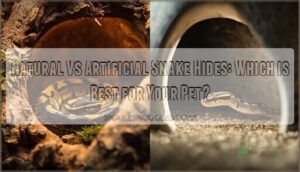This site is supported by our readers. We may earn a commission, at no cost to you, if you purchase through links.

You’ll discover that male snakes don’t bring flowers – they release pheromones that act like chemical love letters.
These scent trails help females identify suitable mates from miles away.
During courtship, males perform elaborate dances, intertwining their bodies in what looks like a graceful wrestling match.
Some species engage in "mating balls" where multiple males compete for one female’s attention.
Temperature and seasonal changes trigger these behaviors, turning spring into snake romance season.
Each species has developed unique courtship strategies that would make human dating apps seem simple by comparison, showcasing the complexity of snake courtship rituals.
Table Of Contents
- Key Takeaways
- Snake Mating Behaviors
- Courtship Ritual Variations
- Reproductive Anatomy Details
- Mating Strategies and Diversity
- Environmental Factors and Reproduction
- Frequently Asked Questions (FAQs)
- What is a courtship ritual in a snake?
- What do snakes do during courtship?
- What are courtship displays in snakes?
- How to observe Snake mating behaviors?
- How does a snake court a female?
- How do snakes mate?
- How long do snake pregnancies typically last?
- Do snakes show any parental care behaviors?
- What age do snakes reach sexual maturity?
- Can different snake species interbreed successfully?
- Conclusion
Key Takeaways
- You’ll discover that male snakes use chemical love letters through pheromones that females can detect from miles away, creating invisible highways that guide courtship behaviors and ensure species recognition.
- You’ll witness elaborate physical displays including chin rubbing, body shuddering, and wrestling matches where males compete for mating rights, with some species forming chaotic mating balls while others perform elegant hood dances.
- You’ll find that environmental triggers like temperature and seasonal changes activate snake romance season, with spring’s warmth breaking winter’s grip to start reproductive cycles that’ve been perfected over millions of years.
- You’ll observe complex reproductive anatomy featuring dual hemipenes in males and sophisticated female organs that enable sperm storage for months, allowing strategic timing of fertilization and diverse mating strategies from egg-laying to live birth.
Snake Mating Behaviors
You’ll observe that snake mating behaviors involve complex chemical communication and physical displays that determine reproductive success.
When you study these courtship rituals, you’re witnessing millions of years of evolutionary adaptation where pheromone detection, male competition, and precise anatomical coordination guarantee species survival.
Environmental Triggers for Mating
When spring’s warmth breaks winter’s grip, you’ll witness nature’s most reliable matchmaker at work.
Nature’s ancient choreography unfolds as chemical signals guide serpentine courtship through evolutionary pathways perfected over millennia.
Temperature cues trigger snake mating season as rising degrees activate reproductive hormones. Rainfall effects boost food availability while humidity levels create ideal breeding conditions.
Habitat quality determines reproductive success, making conservation impact vital for maintaining genetic diversity.
Environmental cues orchestrate this ancient dance perfectly. Snakes often exhibit increased activity during this period, showcasing the natural balance.
Role of Pheromones in Mate Selection
When environmental conditions align, female snakes become chemical matchmakers. You’ll find snake pheromones creating invisible highways that males follow using their Jacobsen’s organ.
This chemical communication system guarantees species recognition while maintaining reproductive isolation.
Pheromone signaling involves four key elements:
- Scent trail variations guide males to receptive females
- Pheromone diversity prevents cross-species mating attempts
- Snake courtship signals indicate female readiness timing
- Scent communication travels considerable distances effectively, ensuring species recognition and reproductive isolation.
Courtship Rituals and Displays
Once you’ve detected those chemical signals, you’ll witness fascinating snake courtship displays unfold.
Males perform intricate physical displays including chin rubbing, body shuddering, and tail quivering that create tactile vibrations along the female’s body.
These snake courtship rituals vary dramatically between species – from garter snakes forming chaotic mating balls to king cobras spreading their hoods in elaborate shows of strength and fitness.
Male Competition and Dominance
You’ll witness fierce wrestling matches when male snakes compete for mating rights.
These combat durations can stretch for hours as males intertwine their bodies, displaying raw strength through dominance displays.
Garter snakes create chaotic mating balls where dozens of males swarm one female.
Winners earn mating privileges through these agonistic behaviors, while losers retreat.
Successful males then practice mate guarding, protecting their investment from rival competitors.
Courtship Ritual Variations
You’ll discover that snake courtship behaviors differ dramatically across species, from garter snakes forming chaotic mating balls to king cobras performing elegant hood displays and rapid coiling dances.
These variations reflect each species’ unique evolutionary adaptations to environmental pressures, geographic locations, and reproductive strategies that maximize mating success in their specific habitats, influenced by evolutionary adaptations and reproductive strategies.
Species-Specific Mating Behaviors
Different snake species showcase unique courtship rituals that’ll fascinate you.
Garter snakes form mating balls with dozens of males competing for one female, while king cobras perform elaborate hood displays and rapid coiling dances.
Combat rituals vary dramatically – rattlesnakes engage in wrestling matches, whereas brown tree snakes demonstrate unusual female courtship behaviors.
Each species’ physical displays reflect their evolutionary adaptations. Over 3,900 species have been identified, highlighting their remarkable adaptability, which is a key aspect of their biological success.
Geographic Influences on Courtship
Geographic location shapes snake courtship rituals more than you’d expect.
Regional variations create fascinating adaptations across different climates and terrains.
Snake courtship rituals vary dramatically based on environmental conditions:
- Habitat Specificity – Desert snakes court during cooler hours while rainforest species remain active throughout day
- Climatic Adaptations – Northern populations show intense spring mating after hibernation versus tropical year-round breeding
- Prey Availability – Resource-rich areas support longer courtship displays and increased male competition
- Population Density – Crowded habitats intensify male combat behaviors and territorial disputes
- Geographic Ranges – Isolated populations develop unique mating strategies specific to local conditions
Impact of Climate Change on Mating
Climate change wreaks havoc on snake mating rituals as temperature shifts disrupt traditional breeding cycles.
You’ll notice breeding disruption when environmental conditions become unpredictable, affecting hatchling survival rates across populations.
These temperature influences create genetic impacts that threaten species diversity. Scientists develop conservation strategies to protect snake breeding habitats, ensuring these remarkable reptiles can adapt to our changing world, which is crucial for their breeding habitats.
Reproductive Anatomy Details
You might think snake reproduction is straightforward, but these reptiles have evolved surprisingly complex anatomical structures that’d make even the most experienced biologist pause and take notes.
Understanding hemipenes, cloacal mechanics, and sperm transfer systems reveals how nature has engineered these creatures for reproductive success in ways that often challenge our assumptions about simple animal mating.
Structure and Function of Hemipenes
Male snakes pack a unique reproductive surprise: two hemipenes tucked inside their tail base.
These specialized organs remain inverted until mating time, when muscle action flips them inside-out for sperm transfer.
Hemipene morphology varies dramatically between species, creating evolutionary advantages through enhanced mating success.
Each snake’s courtship rituals depend on these remarkable structures, which function independently during different encounters, showcasing their reproductive capabilities.
Female Reproductive Organs and Mating
Female snakes possess sophisticated reproductive anatomy that facilitates successful mating. You’ll find their cloacal anatomy contains both a vaginal opening and a clitoris function that signals mating receptivity to males.
Key aspects of female snake reproductive anatomy include:
- Internal structures adapted for hemipene insertion during copulation
- Specialized cloacal design enabling precise sperm reception
- Chemical signaling systems that communicate female receptivity
- Muscular control mechanisms for successful fertilization
- Behavioral adaptations coordinating with male courtship advances
Interestingly, some species exhibit parthenogenesis capabilities, reproducing asexually.
Mechanisms of Sperm Transfer and Fertilization
Something remarkable happens when you witness snake reproduction firsthand.
During mating, males insert specialized hemipenes into the female’s cloaca, ensuring precise cloacal alignment for ideal sperm transfer.
Hemipene morphology varies dramatically between species, affecting fertilization timing and success rates.
Females can store viable sperm for months, controlling when fertilization occurs, this strategic sperm storage maximizes genetic contribution opportunities.
Mating Strategies and Diversity
You’ll discover that snakes employ remarkably diverse reproductive strategies, from egg-laying pythons to live-bearing garter snakes, with some species even reproducing without males through parthenogenesis.
These varied approaches showcase nature’s clever adaptations, allowing different snake species to thrive in their specific environments while ensuring successful offspring survival, highlighting the importance of successful offspring.
Oviparous Vs Viviparous Reproduction
Different reproductive strategies showcase evolution’s brilliant adaptability in snake species.
You’ll find that oviparous vs viviparous methods depend on environmental pressures and species needs. Geographic variation influences whether snakes choose egg laying or live birth approaches.
Here are three key evolutionary advantages:
- Oviparous species benefit from reduced energy costs and faster recovery between breeding cycles
- Viviparous snakes provide enhanced parental care through internal development and protection
- Environmental adaptation allows species to optimize survival based on climate and habitat conditions
During mating, males may use two hemipenes to transfer sperm.
Parthenogenesis and Asexual Reproduction
Some snake species break conventional mating rules through parthenogenesis—nature’s ultimate backup survival strategy.
You’ll find this asexual reproduction fascinating as females produce offspring without male genetic contribution, offering significant evolutionary advantages when mates are scarce.
| Species | Type | Conservation Applications |
|---|---|---|
| Flowerpot Snake | Obligate | Population maintenance |
| Burmese Python | Facultative | Endangered species protection |
| Green Anaconda | Facultative | Habitat fragmentation survival |
| Elapid Species | Facultative | Genetic diversity preservation |
However, genetic implications include reduced diversity over time, which can have significant effects on the long-term survival of these species, highlighting the importance of conservation applications and understanding the role of parthenogenesis in their survival strategy.
Adaptive Reproductive Methods in Snakes
You’ll discover that reproductive flexibility gives snakes their evolutionary edge through diverse strategies.
Environmental adaptation drives whether species choose egg laying or live birth based on climate conditions.
Parthenogenesis benefits isolated females by enabling reproduction without males, while traditional snake courtship guarantees genetic diversity.
These courtship rituals and snake mating behavior maximize reproductive success across changing habitats, proving nature’s incredible adaptability.
Environmental Factors and Reproduction
You’ll discover that environmental conditions act as nature’s matchmaker for snakes, with temperature changes and seasonal shifts triggering their reproductive cycles.
These external factors don’t just influence when snakes mate—they determine breeding success, offspring survival, and the timing of courtship behaviors that guarantee species continuation.
Temperature and Humidity Effects on Mating
After exploring reproductive diversity, you’ll notice how temperature triggers and humidity impacts shape snake mating behavior.
Environmental cues like warmth and moisture signal the start of reptile courtship behaviors.
Here’s what matters most:
- Temperature triggers hormonal surges.
- Humidity levels affect courtship rituals.
- Clutch size depends on stable conditions.
- Hatchling survival links to moisture.
- Climate disruption alters breeding success.
Ideal conditions include specific temperature ranges, which is crucial for reproductive success.
Habitat Quality and Nesting Site Selection
Beyond temperature considerations, habitat quality dramatically shapes where you’ll find snakes establishing their nests.
Females assess multiple environmental factors before committing to egg laying locations.
| Habitat Factor | Optimal Conditions | Impact on Success |
|---|---|---|
| Nesting Materials | Decaying vegetation, soft soil | Enhanced insulation, moisture retention |
| Site Microclimate | Stable temperature, adequate humidity | Improved embryonic development rates |
| Predator Avoidance | Hidden locations, dense cover | Reduced clutch predation risk |
Smart clutch placement guarantees offspring survival in increasingly fragmented landscapes.
Regular cleaning helps maintain proper reptile hygiene.
Conservation Efforts for Healthy Snake Populations
Protecting reproductive success requires thorough snake conservation efforts that address multiple environmental challenges.
You’ll find that habitat preservation directly supports prey abundance while maintaining genetic diversity strengthens climate resilience against changing conditions.
Effective snake population management includes:
- Establishing protected breeding corridors
- Monitoring snake biodiversity maintenance programs
- Reducing human impact through education initiatives
- Supporting specialized snake breeding programs
Frequently Asked Questions (FAQs)
What is a courtship ritual in a snake?
Like nature’s ancient dance, you’ll witness males performing an intricate ballet of pheromone detection, chin rubbing, and body undulations.
They’re basically wooing females through chemical signals, tactile stimulation, and competitive displays that demonstrate their genetic fitness.
What do snakes do during courtship?
You’ll observe males following pheromone trails, performing chin rubbing and body shuddering to stimulate females.
They engage in wrestling matches for mating rights, then wrap around females for copulation lasting hours.
What are courtship displays in snakes?
Scientists once theorized snakes lack complex behaviors, but you’ll witness elaborate displays proving otherwise.
Males perform chin rubbing, body undulations, and hood spreading.
They’ll wrestle competitors while females release pheromones, creating nature’s most intimate dance.
How to observe Snake mating behaviors?
You’ll need patience and the right timing to witness snake mating rituals.
Visit during spring’s warming period when they’re most active.
Look for wrestling males, pheromone trails, and distinctive courtship behaviors like chin rubbing.
How does a snake court a female?
Actions speak louder than words in snake romance.
Males follow your female’s pheromone trail, then perform chin rubbing, body shuddering, and tail quivering.
They’ll wrestle competitors before aligning cloacas for successful mating.
How do snakes mate?
During mating, you’ll see males wrap around females, positioning their cloacas together. Males insert one hemipene into the female’s cloaca, transferring sperm through this intimate embrace that can last hours.
How long do snake pregnancies typically last?
Female snakes carry their developing offspring for vastly different periods depending on species.
You’ll find gestation ranges from two months in smaller species to nearly eight months in larger pythons and boas.
Do snakes show any parental care behaviors?
You’ll find most snakes abandon their eggs or babies after birth, showing minimal parental investment.
However, some pythons coil around their eggs, regulating temperature through muscle contractions until hatching occurs successfully.
What age do snakes reach sexual maturity?
You’ll notice snakes typically reach sexual maturity between 2-4 years old, depending on their species and size.
Larger species like pythons mature later, while smaller snakes like garters breed sooner when conditions are right.
Can different snake species interbreed successfully?
Snake species typically can’t interbreed successfully due to genetic incompatibility.
You’ll find closely related species occasionally produce hybrid offspring, but they’re usually sterile or have reduced survival rates, preventing successful long-term reproduction, which often involves sterile offspring.
Conclusion
Some snake species can detect pheromones from potential mates over three miles away, demonstrating nature’s incredible chemical communication system.
You’ve now explored how understanding snake courtship rituals reveals complex behaviors that guarantee species survival.
From elaborate mating dances to competitive wrestling matches, these reptiles employ sophisticated strategies that’d make dating apps jealous.
Temperature changes trigger romantic seasons, while pheromone trails guide mate selection, showcasing evolution’s creativity in developing reproductive success strategies across diverse snake species worldwide, highlighting the complex behaviors and elaborate mating dances that contribute to their survival.
- https://www.discoverwildlife.com/animal-facts/reptiles/how-do-snakes-mate
- https://talis-us.com/blogs/news/do-snakes-go-into-heat-exploring-snake-reproduction?srsltid=AfmBOorDfJyQogNU5UluHYi82fPfNqo5tXSqt7SyQwhilsa98i7Kt3eY
- https://timesofindia.indiatimes.com/etimes/trending/how-do-snakes-reproduce-ovoviviparity-will-leave-you-amazed/articleshow/116212901.cms
- https://redinational.com/what-preventative-measures-can-be-taken-during-snake-mating-season/
- https://animals.howstuffworks.com/snakes/how-do-snakes-mate.htm














